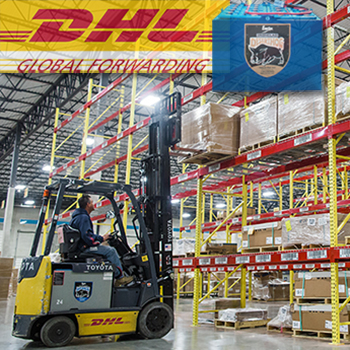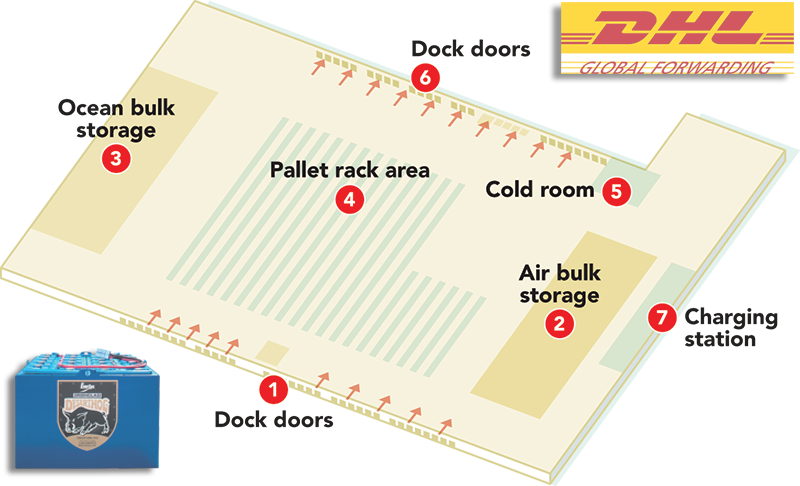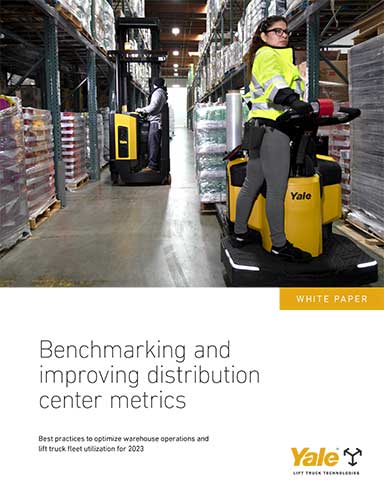DHL Global Forwarding Electric Forklift Conversion
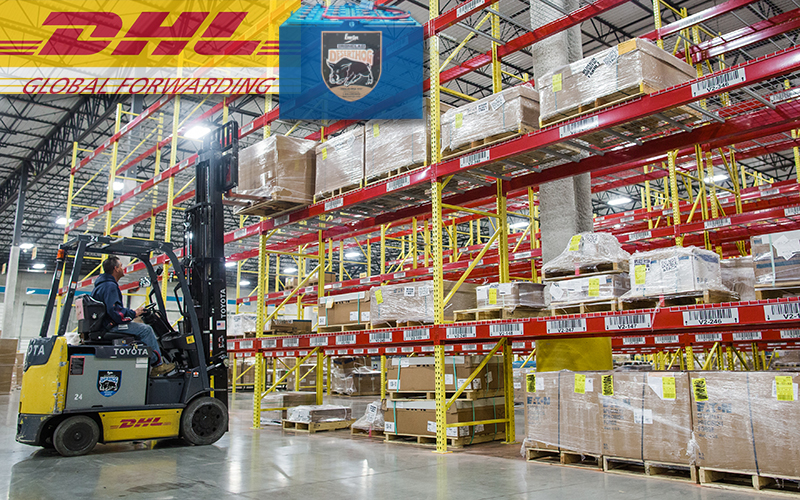
For a new facility in Chicago, DHL Global Forwarding converted to electric lift trucks, and the results provide better uptime and a cleaner environment.
With all the talk of automation, robotics and the Internet of Things, it’s easy to forget that not every facility has to pick thousands of individual items to fill e-commerce orders in 30 minutes or less to move their businesses forward.
Just as there are times when a hammer, screwdriver and pliers are the right tools for the job, many finished goods warehouses and crossdocking facilities rely on the fundamentals of lift trucks and floor and rack storage, while optimizing their processes with software tools like warehouse management systems (WMS) and transportation management systems (TMS).
That’s the case at Chicago’s O’Hare Airport, where DHL Global Forwarding opened a state-of-the-art crossdocking facility to handle export and import shipments for customers in the high tech, manufacturing, engineering and pharmaceutical and life sciences industries, to name a few.
“While many organizations’ supply chains rely heavily on technology, oftentimes, there are quicker and less costly options” - Allison Ryder and John A. Caltagirone
The process is simple: Cargo is picked up by DHL’s fleet at an airline or a customer’s manufacturing location, or a customer delivers product from its plants. Once received, the cargo goes through security screening, is cleared by customs, is deconsolidated by customer and final delivery location and, finally, is consolidated into outbound shipments.
All of that activity happens as quickly as possible: Roughly 80% of the cargo is available for outbound shipment within 24 hours of receipt and 90% moves through the facility in 30 hours. For its most demanding customers, cargo is picked up within four hours of arrival at the airport and is back on an outbound flight within 6 hours of its receipt at the facility.
“We focus on minimizing warehouse dwell time, or how long the cargo is in our facility,” says Brian Lindholm, an executive vice president for the central region of the United States. “It’s a touch-and-go process. The ideal operational model is that we receive freight and by the end of the day we flush out as much as we can.”
To keep that cargo in motion, DHL relies on basic tools, like floor and rack storage and a proprietary WMS and TMS. More importantly, it converted a fleet of propane-powered lift trucks from its old facility to a new fleet of 62 electric vehicles that uses high capacity batteries and opportunity charging (EnerSys).
The combination has delivered a number of benefits
- Opportunity charging minimizes downtime: The units rarely drop below a 45% charge.
- The environment is cleaner: Because electric trucks are emission free, the air is cleaner and greasy film no longer settles on equipment and cargo.
- The environment is safer: Associates no longer risk an injury from replacing propane tanks and with opportunity charging there’s no need for a battery room.
- DHL is realizing savings: The company estimates that it will save about $100,000 in operational costs over five years.
Just how important are the trucks to the new facility? “We handle about 45 million pounds of cargo a month and operate around the clock every day of the year but Christmas,” Lindholm says. “The lift trucks operate nonstop.”
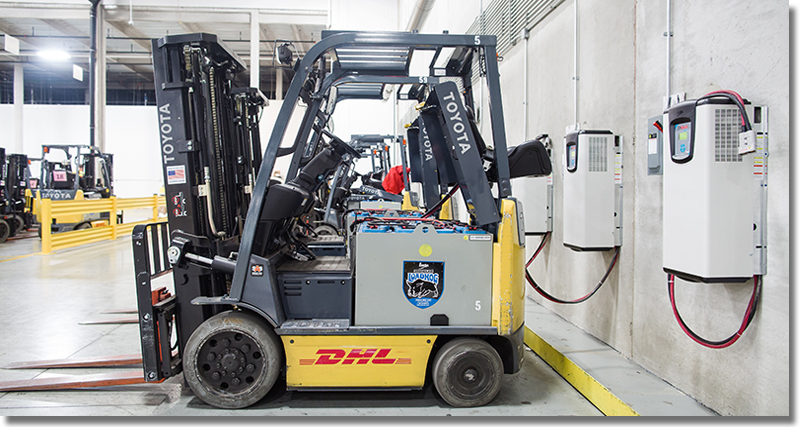
Moving it Forward
With more than 325,000 employees and a presence in more than 220 countries and territories across the globe, DHL is one of the most international companies in the world.
Similarly, the DHL Global Forwarding business unit is a leader in the efficient coordination and movement of freight worldwide, with the size and experience to tailor highly competitive solutions for small businesses looking to move less than a container, or large experienced customers with extensive air and ocean freight operations.
Lindholm points out that as recently as last November, the Chicago facility shipped 27 truckloads of cargo in four hours for one customer.
The facility is always working against the clock. Every move is time and date stamped from the time a shipment is picked up at an airline until cargo is delivered to the customer for import shipments, or from the time an export shipment is picked up from a customer to its final destination at the airport. Meanwhile, digital monitors located throughout the facility display completion rates for the orders being consolidated against the airline’s cutoff time.
Transparency counts: Real-time information is available to customers, and for the most time-sensitive clients, Lindholm says DHL captures milestone updates that allow customers to make their other supply chain arrangements.
Freight forwarding is also evolving to meet the changing needs of its customers.
“There was a time when just getting the cargo to its final destination on time and without damage made everyone happy,” Lindholm explains. “Today, you not only have to move the cargo, you have to provide all of the data associated with those moves, provide value-added services like customs clearance, deconsolidation and consolidation, and do all of those things at a very competitive price.”
In addition, specialized areas like maintaining the cold chain for industries like life sciences and pharmaceuticals is a critical and growing side of the business. “Back in the 1990s, all we needed for the cold chain was a box freezer like you’d put in your garage,” Lindholm says.
Today, DHL operates some 74 certified life sciences stations around the globe, with another 18 locations under consideration. Those facilities can provide seamless end-to-end transport of temperature-sensitive products to more than 2,000 trade lane pairings.
Opened in January 2015, the new $35 million Chicago facility was designed to meet those evolving needs. With 491,000 square feet of warehouse and office space, it is the largest free-standing facility in DHL Global Forwarding’s network, replacing a smaller facility that was further from the airport.
It is a certified life sciences station, with a 10,000-square-foot, temperature-controlled space that reaches to 30 feet with pallet and rack storage. In addition, the building has been designated a Foreign Trade Zone (FTZ) and features a secure area under the supervision of U.S. Customs and Border Protection agency that is outside the Customs territory for the purposes of duty-payment.
It is also Customs-Trade Partnership Against Terrorism (C-TPAT) validated; TSA Certified Cargo Screening Facilities (TSA CCSF) certified; and Transported Asset Protection Association Americas (TAPA-A) certified. Last, but not least, it was designed with environmentally friendly interior features, such as energy efficient lighting and water fixtures and low emitting indoor air contaminants, with an eye toward LEED certification.
The facility was designed from the ground up to enable the efficient flow of cargo through the building. “We have about 15% more square footage than we had in our other building,” says Lindholm, “and in our old building, all of the dock doors were on one side of the building.” Today, freight is received on docks located on the south side of the building, and then moves toward the north side of the building as it is screened, deconsolidated, put away into temporary storage and then built into export shipments on airplane pallets at build stations at the shipping docks. “We now have a true crossdock facility,” Lindholm says.
Converting to Electric
The migration from propane- to electric-powered lift trucks was in keeping with a fresh design to meet the needs of DHL’s customers as well other corporate goals.
Take sustainability, for instance, which is a priority at DHL. “We want to be a good corporate citizen and clean energy efficiency is something we look for,” Lindholm says. He adds that LP lift trucks have lower upfront costs, but they are not considered “green” and don’t deliver the same environmental and energy advantages of electric lift trucks.
Beyond fuel efficiency, he adds, DHL wanted a new facility that was cleaner, quieter and had better air quality than in its former facility. There, the propane-powered lift trucks emitted fumes that could be smelled on the floor and left a fine coat of greasy soot on equipment and cargo. Safety was also enhanced because the electric lift trucks are much quieter than propane trucks, which get louder as they age. The new lift trucks also have an onboard computer that automatically powers down when a load is too heavy for the truck, preventing operators from pushing past recommended limits.
“We’re investing in equipment that provides a better working environment for the people on the floor,” Lindholm says. “The electric lift trucks are quieter, the air quality is better because there are no fumes, and there are ergonomic benefits as well because operators aren’t swapping out propane tanks.”
Given the importance of lift trucks to DHL’s operations, the real challenge was to design a solution that met the 24/7 performance requirements for the fleet. To that end, DHL’s solution provider recommended a high-capacity battery that has about 10% more amps than a standard battery - essentially the equivalent of putting a larger gas tank that can hold more fuel in a conventional vehicle.
In addition, some 50 opportunity chargers were installed close to the break room, the time clock and locker room. Another 10 chargers are in strategic locations around the facility. Typically, batteries get a 10- to 20-minute boost during shift changes or whenever operators have down time for lunch or other breaks. The opportunity chargers bring the batteries up to a minimum 60% charge, and Lindholm says they never drop below a 45% charge during a shift.
To date, DHL says that electric forklifts have performed as well as propane-powered trucks on critical metrics such as a right-angle stack, lift and travel speeds, and turning radius.
Maintenance requirements have also been reduced as a result of opportunity charging. For one, batteries never leave the lift truck so there is no need for a battery room. Instead, each battery receives a four- to five-hour equalization charge once a week, usually on a Sunday or a Monday.
DHL takes 20 trucks at a time out of service, or about 30% of the fleet, and simultaneously equalizes them, puts them back in service and then equalizes the next 20 trucks. Lindholm says that DHL expects to realize a 60% reduction in maintenance hours since there are fewer moving parts in the electric trucks. Moreover, the wireless monitoring system alerts operators to when a battery needs to be charged or serviced, and allows managers and vendors to monitor how the batteries are performing. That information can be used by managers to improve the overall fleet performance.
Now that the fleet has been in operation for just more than a year, Lindholm says DHL views electric lift trucks as a critical component of its business continuity strategy for the facility. “In the event of a natural disaster, we will still need to move freight,” Lindholm says. “With our own on-site generator and opportunity charging, we minimized any disruptions to our operations. That’s a decisive benefit.”
And moving forward, he adds, electric lift trucks will allow DHL to take advantage of space saving strategies, such as narrow aisle storage areas. “Electric trucks are smaller and more nimble moving around the warehouse,” he says. “That smaller turn radius is going to be important in the future as we take advantage of the cubic space in the facility and go vertical.”
Freight in Motion
DHL Global Forwarding relies on electric lift trucks, rack and floor storage, and supply chain execution software to efficiently and quickly receive and prepare freight for export around the globe.
Opened early last year, DHL Global Forwarding’s 445,000-square-foot distribution center located next to the runways at Chicago’s O’Hare airport is the largest facility in its North American network. Using efficient processes enabled by electric lift trucks and real-time execution software, most cargo is inspected, cleared through customs and ready for shipment within 24 hours of receipt.
Designed from the ground up for crossdocking, product comes in through dock doors on the south side of the building, is processed in the middle and consolidated for shipment on the north side of the building near the shipping docks. Finally, the facility handles export and import product, with processes for both. Note the opportunity charging stations (7), where lift trucks are charged during breaks.
Receiving - Export: The receiving process for cargo that will be exported starts when a customer drops off freight at the dock doors (1) on the north side of the facility or DHL sends its own fleet to a customer site to pick up the cargo. Electronic advanced ship notifications (ASN) from the customer are received in DHL’s warehouse and transportation management system; DHL creates an entry in the system for freight that it picks up.
Once the cargo is at the facility, a unique bar code label is assigned to each piece and the newly arrived cargo is scanned into a Web-based distribution system that is visible to DHL and to its customers in real time. As a certified cargo screen facility, DHL performs the screening required by the TSA. Upon completion of screening, the freight is scanned into a bin location, where it will remain until it is consolidated into an outbound shipment.
Depending on how it will be shipped, cargo is stored in an air bulk storage area (2), an ocean bulk storage area (3) or in a pallet rack area (4) in the center of the building. The facility also includes a cold room (5) for cold chain products. During the induction process, information is captured that will be used to create export documents, such as the shipper, the consignee, the weight and size of the packages and the final destination. That information is fed into the transportation management system (TMS).
Consolidation and Shipping – Export: Once the order consolidation process begins, DHL associates work against the clock to prepare an outbound shipment in time to deliver it to an airline before the lockout period, after which freight can’t be loaded.
Digital dashboards are located throughout the warehouse floor that display the lists of active consolidations taking place at any given time as well as the percentage of completion of the orders against the time remaining to meet the lockout time. Picking instructions, including the location of the material to be picked and the flight instructions are sent to the lift truck drivers’ handheld scanners.
Once the pieces are picked, they are consolidated near the shipping docks on the south side of the facility (6) and built on a unit load device, or ULD, which is a pallet or container used to load luggage, freight and mail for air transport and then loaded on to a roller bed trailer. The information captured during induction is used to create export and shipping documents. Once all the pallets have been built, they are delivered to the appropriate airline.
Receiving – Import: Whenever possible, drivers making deliveries to an airline pick up import cargo from the same airline or another airline so they don’t deadhead back to the facility. Airplane pallets are loaded onto the roller bed trailers. Because time is critical in the freight forwarding business, every movement and process is time and date stamped, beginning with receipt from the airline.
Back at the facility, ULDs are received (1), put through ULD break-bulk processes and put away by the customer in the appropriate storage location (2, 3, 4, 5) and airway bills after being scanned by a handheld bar code scanner. Once the shipment clears customs, product is ready for its final mile delivery.
Consolidation and shipping – Import: In most respects, the consolidation and shipping process for import items mirrors the same process for export items. Lift truck drivers receive picking and delivery instructions on their handheld devices. Once the items for an order have been picked, they are staged at the shipping docks (6) for preloading checks and then loaded onto DHL trailers and trucks for delivery to the customer.
System Suppliers
High capacity batteries and opportunity charging system: EnerSys
Lift Trucks: Toyota Material Handling U.S.A.
Download: The Truth about Electric Lift Trucks and Their Impact on Your Operations
Article Topics
Yale News & Resources
Should you lease or buy your lift truck fleet? Electric Trucks are Poised to Tackle the Pressures of E-commerce Improving Distribution Center Metrics New Technology Can Give Lift Truck Operators a Hand 2022 Warehouse Benchmarks Study 70% of forklift accidents in the United States are preventable Robotic lift trucks can cut operating expenses up to 70% More YaleLatest in Warehouse|DC
U.S. Manufacturing Gains Momentum After Another Strong Month Biden Gives Samsung $6.4 Billion For Texas Semiconductor Plants Walmart Unleashes Autonomous Lift Trucks at Four High-Tech DCs Plastic Pollution is a Problem Many Companies are Still Ignoring The Harsh Reality for Amazon and Walmart Warehouse Workers Supply Chain Stability Index: “Tremendous Improvement” in 2023 AI Not a Priority for Retailers and CPG Companies More Warehouse|DCAbout the Author
